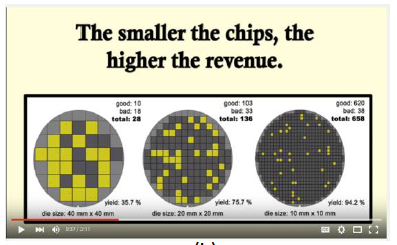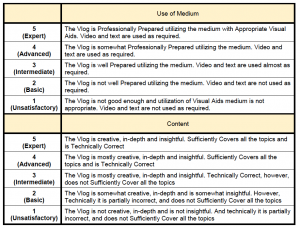Tags: Assessment, Constructivism, Engagement, Engineering, Flipped Classroom, Interaction, Large Classes, STEM, Video
Description
It has been a challenge to engage students in large-enrollment classes, especially in the science, technology, engineering, and mathematics (STEM) disciplines. The larger the class size is, the less likely students will actively engage in class activities (Rocca, 2010). The lack of engagement creates information overload (Hewitt & Brett, 2007), which consequently resulted in student dropout. There is an urgent need to seek engagement strategies in large-enrollment STEM courses.
The constructivist learning theory indicates that student engagement and learning gains are the best when they construct their own understanding and knowledge through experiences and reflections rather than learning passively (Ackermann, 2004). Innovative instructors introduced the strategy of using student-generated video blogs in foundational STEM courses and found student engagement was enhanced through developing a personal connection to the subject (Lawrie & Bartle, 2013).
Link to example artifact(s)
Dr. Ronald DeMara and his Teaching Assistants (TAs) introduced this Learner Video Thumbnailing (LVT) activity as a method to increase engagement in his large-enrollment undergraduate course, Computer Organization and Design. In this activity, student volunteers (vloggers) can earn extra credits for creating short online videos reflecting course topics. Other students can also earn extra credits being a spectator by responding to online technical questions regarding the content of the videos.
Vlogger
Three times during the semester, students were offered an extra-credit opportunity to create a 2-3 minute video summarizing key concepts covered in the class in his/her own words. Students voluntarily signed up for this opportunity to be a vlogger using an online form and were provided with an LVT preparation checklist (below).
- Step 1: Google a few keywords related to a picture which is related to course topics in order to locate some visual aids.
- Step 2: If vloggers want to make more technical vlogs including lots of details they can use some of the course materials or other resources available on the web.
- Step 3: The vlog production process from start to finish can take 30 minutes or less. There is no need to spend more than an hour to prepare the vlog, however, making the vlog is also studying course materials which can be helpful for the vlogger in order to prepare for an upcoming quiz/exam/etc.
- Step 4: Vloggers are allowed to use their sense of humor and have some fun parts in their vlog which will make this with this method an interesting interactive way to prepare for an upcoming quiz/exam/etc.
- Step 5: Upload the video to your personal YouTube channel and submit the link in the course assignment to earn extra credit.
In the 2015 Fall semester, an average of 5-8 online videos were created by Vloggers for each session. The below sample video (right) was created based on the visual aid provided by the instructor in the class notes (left).
Figure 1: Visual Aid from Module 8: Device Technology
Video: Student, Devin Hobby, created this video in response to the visual aid in Module 8: Device Technology
Additional student vlogs can be viewed at:
- https://www.youtube.com/watch?v=FjbpMlCHIsw
- https://www.youtube.com/watch?v=-XO2i5JIGLU
- https://www.youtube.com/watch?v=_Ol2tMcbEmc
The submitted videos were rated by the instructor, TAs and peers based on the use of medium and content using the rubric below. The top rated video will be played in the next face-to-face class to engage further discussions. To encourage student participation, Vloggers always earn their full extra credit, as long as they follow the provided checklist.
Spectator
The instructor and the TAs prepared at least one question based on each student-created video to include in the spectator extra credit quiz. Some questions included partial extra credit because the questions can have multiple answers. All students can be the spectators to participate in this online spectator extra credit quiz. Here is a list of sample technical questions included in the quiz:
- As covered in the vlog today, which of the following elements of the periodic table is considered to be a semiconductor?
- As covered in the vlog today, what year was the transistor invented by Shockley?
- As covered in the vlog today, which of the following processors is popular for IoT devices?
During the Fall 2015 semester, the majority students participated in this spectator quiz to earn extra credit.
Outcomes
The Learner Video Thumbnailing (LVT) is an engaging strategy that STEM instructors can use in a class to facilitate learners’ reflective thinking through learner-created videos. Students appreciated the opportunity to express their creativity and responded by creating visually appealing interactive assignments (DeMara, Salehi, & Muttineni 2016). The instructor and TAs are encouraged by the student responses using this creative, yet structured approach for increasing engagement in exam preparation. The instructor was able to include the learner-created videos for use in future semesters of the course with students’ permissions. Additionally, the vlogging undergraduates obtained a discussion-inspiring resume item to include mentioning on resumes as a creative derivative work.
Link to scholarly reference(s)
Ackermann, E. (n.d.). Constructing knowledge and transforming the world. In M. Tokoro & L. Steels (Eds.), A learning zone of one’s own: Sharing representations and flow in collaborative learning environments (pp. 15–37). Washington D.C.: IOS Press. Retrieved from http://web.media.mit.edu/~edith/publications/2004-Constructing_Knowledge.pdf
DeMara, R., Salehi, S., & Muttineni, S. (2016). Exam preparation through directed video blogging and electronically-mediated realtime classroom interaction. Proceeding from 2016 ASEE: The American Society for Engineering Education Southeast Section Conference. Tuscaloosa, AL. March 13-15.
Hewitt, J., & Brett, C. (2007). The relationship between class size and online activity patterns in asynchronous computer conferencing environments. Computers & Education, 49(4), 1258–1271. https://doi.org/10.1016/j.compedu.2006.02.001
Lawrie, G., & Bartle, E. (2013). Chemistry Vlogs: A vehicle for student-generated representations and explanations to scaffold their understanding of structure-property relationships. International Journal of Innovation in Science and Mathematics Education, 21(4), 27–45. Retrieved from http://openjournals.library.usyd.edu.au/index.php/CAL/article/view/7298
Rocca, K.A. (2010). Student participation in the college classroom: An extended multidisciplinary literature review. Communication Education, 59(2), 185-213. https://doi.org/10.1080/03634520903505936
Citation
DeMara, R., Salehi, S., & Muttinenti, S. (2016). Use learner created videos for student engagement in a flipped classroom. In B. Chen & K. Thompson (Eds.), Teaching Online Pedagogical Repository. Orlando, FL: University of Central Florida Center for Distributed Learning. https://topr.online.ucf.edu/using-learner-created-videos-for-student-engagement-in-a-flipped-classroom/?rev=4466.Post Revisions:
- August 25, 2020 @ 15:41:34 [Current Revision]
- August 25, 2020 @ 15:41:34
- August 6, 2020 @ 14:24:31
- July 16, 2020 @ 19:20:24




